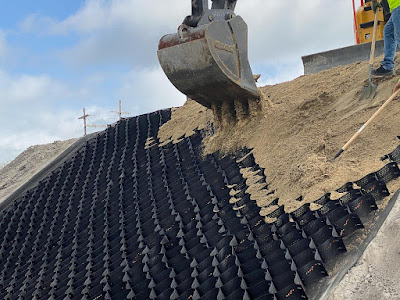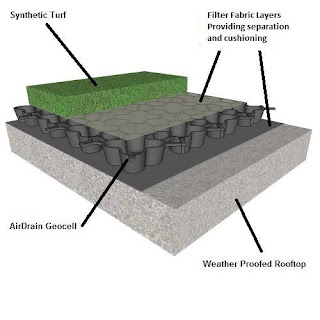Search This Blog
Most Popular
Categories
- Building Construction (77)
- Building Materials (75)
- Columns (2)
- Concrete Beam (3)
- Concrete Construction Techniques (4)
- Concrete Mix Design (9)
- Concrete Repair (13)
- Concrete Slab (10)
- Construction Equipment (15)
- Construction News (7)
- Design of Structures (15)
- Engineering Drawing (1)
- Estimation (3)
- Geotechnical engineering (25)
- Highway Engineering (11)
- Innovations (27)
- Material Testing (8)
- Matrix Analysis of Structures (2)
- Mechanical Engineering (3)
- Transportation Engineering (9)
Geocells in Construction | Working & Types
Neenu
May 03, 2023
Have you ever wondered how engineers manage to build stable structures on weak or unstable soil? The answer lies in the innovative technology of geocells.
Geocells are cellular confinement systems consisting of interconnected plastic cells filled with soil, gravel, or other granular materials. These geocells provide a stable base for construction projects, prevent soil erosion, protects slope and even help with environmental restoration efforts.
In this article, we'll take a closer look at geocells and how they are transforming the way we build on and interact with the natural world.
They possess an open cellular structure and are expandable allowing them to conform to a particular terrain and hold the material from collapsing.
Geocells take the form of a 3D expandable panel and are made from high-density polyethylene (HDPE), polyester, or another polymer material.
What is a Geocell?
Geocells are three-dimensional honeycomb-like structures filled with soil, gravel, or other materials to stabilize the soil and prevent erosion.
They possess an open cellular structure and are expandable allowing them to conform to a particular terrain and hold the material from collapsing.
 |
| Geocells for Slopes Image Credits: BaseLok |
Geocells take the form of a 3D expandable panel and are made from high-density polyethylene (HDPE), polyester, or another polymer material.
Working of Geocells
Geocell reinforcement operates through a set of crucial mechanisms such as vertical and lateral confinement, beam effect, and enhanced load distribution. As the soil enclosed within a geocell undergoes loading, it exerts lateral stresses on the walls of the cell.Thanks to the three-dimensional confinement zone, the geocell restrains the sideward displacement of soil particles. Moreover, the vertical loading applied to the infill leads to substantial lateral stress and resistance at the interface between the cell and the soil.
In the case of pavement construction, cellular confinement systems maintain soil compaction, thereby increasing the structural strength of the infill and pavement layer.
Types of Geocells
The two types of geocells are perforated and non-perforated geocells.
Perforated Geocells
 |
| Perforated Geocells Image Credits: BaseCore |
Perforated geocells have small perforations or holes in their walls to allow water and air to flow through them. The perforations help to improve the load distribution and reduce the chances of distortion.
Non-Perforated Geocells
 |
| Non-Perforated Geocells Image Credits: Jual Geotextile |
These have smooth and solid walls without perforations to prevent the infiltration of water and keep the soil inside the cell.
Advantages of Geocells
The main advantages of geocells are:
- To protect and stabilize steeply sloped surfaces
- To act as a protective lining of channels and hydraulic structures to prevent the entry of soil particles.
- The 3D grid structure of geocells distributes the load coming over it evenly over a larger area and prevents soil failure. Hence they act as static and dynamic load support for weak subgrades.
- To make multi-layered earth-retaining and water-retaining structures.
- The great load distribution capabilities of geocells when applied in road and pavement construction, help to keep the subgrade soil intact for a longer period thus helping to have durable infrastructure.
- Environmentally friendly as geocells can be filled with plants, concrete, or locally available materials like dirt or gravel to confine the area, without the need for quarrying.
Application of Geocells
The major areas of applications of geocells are:
- Road and Pavement Construction
- Landscape Architecture
- Retaining wall, Embankment, and Levees Reinforcement
- Green Roofs and Walls
 |
| Geocells for Green Roof Construction Image Credits: Airfield Systems |
Geocells offer a versatile and eco-friendly solution for a wide range of engineering and environmental challenges. The technology's ability to promote soil stabilization, erosion control, and environmental restoration makes it a popular choice for infrastructure development in the current era where sustainability and eco-friendly practices are highly valued.
As we continue to face growing environmental concerns and strive for sustainable development, geocell technology is likely to play an increasingly crucial role in meeting these challenges. Therefore, it is safe to say that residing in a world where sustainability and eco-friendly practices are highly valued, geocell emerges as a prime alternative as a green solution.
Most Visited
Terzaghi's Equation: Soil Bearing Capacity for Foundations
March 02, 2022
Traverse Surveying - Objective, Method and Procedure
January 19, 2022
Structure of Timber |Macrostructure and Microstructure
March 22, 2024
What are Infiltration Wells?
April 15, 2024
How to Calculate Cement Required for Floor Tiling?
July 02, 2020
What is Target Mean Strength? R.C.C Design
July 17, 2021
Sieve Analysis of Aggregates - ASTM Standard
August 11, 2021
Search This Blog
MUST READ
What is PERT? Objectives, Pros & Cons
September 10, 2017
Terzaghi's Equation: Soil Bearing Capacity for Foundations
March 02, 2022
Contact Form
Footer Menu Widget
Created By SoraTemplates | Distributed By Gooyaabi Templates


0 Comments
Commenting Spam Links Are Against Policies